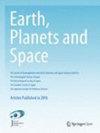Subsurface magma movement inferred from extensometer and tiltmeter records during the early stage of the 2018 Shinmoe-dake eruptions, Japan
IF 2.5
3区 地球科学
引用次数: 0
Abstract
Abstract We infer the temporal changes in the pressure sources that induced crustal deformation during the 2018 Shinmoe-dake eruption using strain and tilt observations and discern that the deep magmatic activity associated with the early stage of this eruption began approximately 19 h earlier than the previously defined onset of magmatic activity. Distinct tilt changes were observed from around 09:00 on 6 March to 12:00 on 8 March 2018 (JST), coincident with observed lava outflow into the crater and lava dome formation. Existing studies have attributed this tilt change to the onset of the deflation of a spherical pressure source located at ~ 7 km bsl (below sea level) to the northwest of Shinmoe-dake. Here we examine strain and tilt data that were acquired in the Kirishima volcanic group, and we find that the distinct changes in the measured strain at Isa-Yoshimatsu Observatory began at around 14:00 on 5 March. This change can be explained by the deflation of a spherical pressure source, thereby suggesting that the onset of magma ascent was earlier than previously thought. The time variation in the spherical pressure source is estimated using the time-dependent inversion of the Ensemble Kalman Filter; the deflation source ascended from ~ 11 to 7 km bsl during Phase 1 (14:00 on 5 March to 06:00 on 6 March) and descended from 7 to 8 km bsl during Phase 2 (06:00 on 6 March to 12:00 on 8 March). Interferometric synthetic aperture radar analysis suggests that a dike intrusion had occurred just below Shinmoe-dake crater until 5 March, and this inflatable crustal deformation is attributed to the emplacement of residual volcanic fluids from the 2011 eruption. It is also known that the surface eruptive activity increased during Phase 1, including an increase in ash venting from the night of 5 March. These strain and tilt observations, therefore, suggest that magma ascended from ~ 11 km bsl to the magma reservoir at 7 km bsl during Phase 1, followed by a deflation of the magma reservoir during Phase 2 due to the large magma supply to the surface. Graphical Abstract根据延伸仪和倾斜仪记录推断的2018年日本shinmoe - ake火山喷发早期的地下岩浆运动
摘要利用应变和倾斜观测资料推断了2018年Shinmoe-dake火山喷发期间引起地壳变形的压力源的时间变化,并发现与此次火山喷发早期相关的深部岩浆活动开始时间比之前定义的岩浆活动开始时间早约19 h。从2018年3月6日09:00到2018年3月8日12:00 (JST),观察到明显的倾斜变化,与观察到的熔岩流入火山口和熔岩穹窿形成一致。现有的研究将这种倾斜变化归因于位于新茂湖西北方向约7 km bsl(海平面以下)的球形压力源的开始收缩。本文对雾岛火山群的应变和倾斜数据进行了分析,发现伊沙吉松天文台的应变测量值在3月5日14:00左右开始发生明显变化。这种变化可以用一个球形压力源的收缩来解释,从而表明岩浆上升的开始时间比以前认为的要早。利用集合卡尔曼滤波器的时变反演估计了球面压力源的时变;在第1阶段(3月5日14:00至3月6日06:00),紧缩源从每小时11公里上升至每小时7公里,在第2阶段(3月6日06:00至3月8日12:00),紧缩源从每小时7公里下降至每小时8公里。干涉合成孔径雷达分析表明,在3月5日之前,Shinmoe-dake火山口下方曾发生过岩脉侵入,这种可膨胀的地壳变形归因于2011年火山喷发后残留的火山流体的侵入。据了解,地表喷发活动在第一阶段有所增加,包括从3月5日夜间开始的火山灰喷发。因此,这些应变和倾斜观测表明,在第1阶段,岩浆从~ 11 km bsl上升到7 km bsl的岩浆库,随后在第2阶段,由于大量岩浆向地表供应,岩浆库出现了收缩。图形抽象
本文章由计算机程序翻译,如有差异,请以英文原文为准。
求助全文
约1分钟内获得全文
求助全文
来源期刊

Earth, Planets and Space
地学天文-地球科学综合
CiteScore
5.80
自引率
16.70%
发文量
167
期刊介绍:
Earth, Planets and Space (EPS) covers scientific articles in Earth and Planetary Sciences, particularly geomagnetism, aeronomy, space science, seismology, volcanology, geodesy, and planetary science. EPS also welcomes articles in new and interdisciplinary subjects, including instrumentations. Only new and original contents will be accepted for publication.
 求助内容:
求助内容: 应助结果提醒方式:
应助结果提醒方式:


